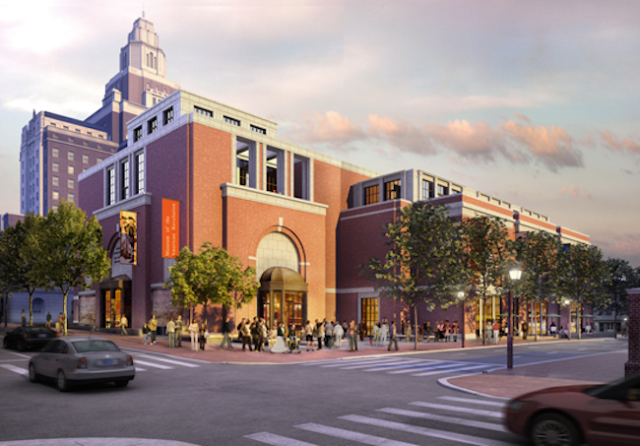
Photo similar to RAMSA photo by Peter Aaron/OTTO. (RAMSA/Wikipedia)
Got a nice mailing the other day from RAMSA – that is, Robert A.M. Stern Architects, Bob Stern’s firm, in New York City. Open the flyer and a photo on two flaps emerges of the Museum of the American Revolution, just opened in Philadelphia. I know the design is excellent because it irks Inga Saffron, the Inquirer’s architecture critic. In “Museum of the American Revolution’s Building at Odds with Revolutionary Content,” she writes:
[A]t some point during the decade-long process of creating this progressive little museum, the goals of its historian-curators and its architects diverged in a big way. In contrast to the narrative estab- lished by the exhibits, the building is overblown in scale, false in its approach to architecture, and stridently conservative in appear- ance.
Saffron likes the museum’s exhibits, which describe (in the words of the New York Times), “the struggles, doubts and halting progress of the Revolution, rather than presenting an idealized account of unity and purpose.” This is as it should be. To present an idealized account of the Revolution’s unity and purpose would be the job of a monument. A more detailed description of the Revolution is the job of history books. A museum sits someplace in between. As the Times says, the museum is “more interested in raising questions than providing answers.” Fine. But as the Times also says, the museum should be “about asking questions of visitors.” No, that’s what a history teacher does, at the high school or the university level. I have not visited the museum yet, but I fear its curators may have gone all-in on interactivity – that is, on trying to entertain young people, not to inform young and old alike.
Confusion of purpose infects our culture’s approach to U.S. history. How this plays out in museums is, alas, probably on display in Philadelphia. It appears that the exhibits may be very trendy, and if so, they reflect today’s curatorial conventional wisdom. So in fact, as Saffron suggests, the purpose of the cur- ators and that of the architects here do diverge in a big way.
Except Saffron has it backward. The curators are highly conventional while the architect, Bob Stern, has approached the museum’s design as a revolu- tionary. For the museum is traditional in appearance, not modernist, as the architectural establishment would prefer. That is why it irks intellectual bureaucrats like Saffron. (In fact, the architectural establishment has a lot more power over what gets built today in America than King George III had over what happened in the colonies.)
Two possible demurrals. First, I could be wrong in assuming that the exhibits are trendy. I have not been there. And I am certainly wrong to suggest that the design of the museum is straightforwardly traditional. Actually, Stern tried to seek a balance between traditional classicism and the context in which the museum sits in Philly, That context is a mixture of both classical and modernist buildings. The museum design’s ornament is more simplified and its massing is less symmetrical than I would have preferred. So it actually defers to both aspects of its setting. Still, the building is not so asymmetrical nor so fully stripped of ornament that its traditional essence is not apparent.
Naturally, of course, Stern gets no credit from Saffron for having tried to balance the old with the new in the museum’s design. She is so deeply sunk in her architectural narrative of “creative” versus “conventional” and “mod- ernist” versus “traditional” that she may not even realize that the museum’s design has any nuance at all.
I hope the Museum of the American Revolution actually does transcend the conventional in its exhibits. In her assessment of its architecture, however, Inga Saffron clearly does not.
The Times story, by Jon Hurdle, is “In Philadelphia, the American Revolution Gets a Museum.” The project partners for the design are Robert A.M. Stern, Alexander P. Lamis and Kevin M. Smith. (The RAMSA website’s version of the flyer’s photo, whose trees seem to have been photoshopped out, may also be by Peter Aaron. I used a photo from Wikipedia because the RAMSA web- site’s version of the photo that I received in the mail was too small.)



I like the word “demurrals”
LikeLike
Usually one offers a blanket demurral but this one is plural.
LikeLike
Thanks for publicizing this museum. It is certainly an attempt at “serious” architecture and as such perhaps it is appropriate for a public that no longer reads and needs reminding of the august nature of our Country’s founding. Unfortunately it comes off more as a shopping mall than a museum. The entrance is tentative and does not open up to the public which , after all it intends to invite, and it seems to be a more or less word for word quotation of 500 Beacon Street, another Stern commercial design. Most disappointing is a button down conservatism while treating a revolution of farmers and rabble rousing patriots who fought the status quo of Kings and Lords. Where is the daring?
LikeLike
Ethan, you seem to be making the same mistake as Saffron. Your critique of the design is valid, and RAMSA has done plenty of modernist work I don’t like, but in this case it is Stern who is the revolutionary. Modernism is the status quo against which this building revolts, which is why apparatchik Saffron does not like it. Same as the patriots of yore.
LikeLike